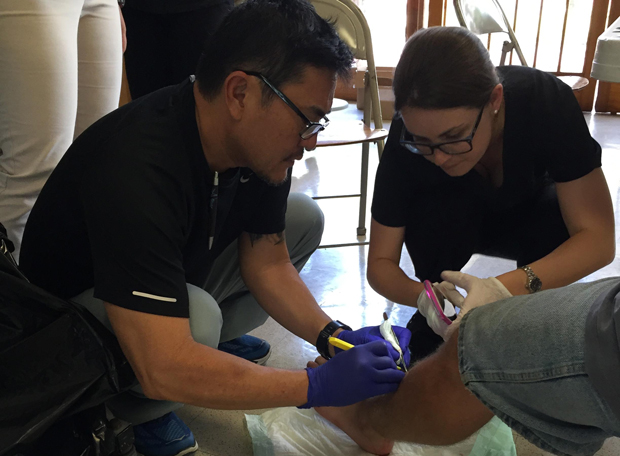The Community Health Outreach Work to Prevent AIDS (CHOW) Project was the first in the nation to offer statewide syringe exchange services. Given the high frequency of wounds associated with injection drug use, CHOW has recently expanded services for their participants to include community-based wound care.
Initially established in 1989 as a University of Hawaiʻi research project, CHOW received funding from the State of Hawaiʻi Department of Health (DOH) after legislation was passed in 1993 in support of syringe exchange as a means to reduce transmission of HIV/AIDS and Hepatitis B and C. CHOW utilizes an evidence-based harm reduction approach with over 200 studies demonstrating the effectiveness of syringe exchange programs in reducing HIV, with no increase in drug use.
“With a patient-centered, harm reduction focus, we treat community members compassionately and non-judgmentally using methods that have been proven to reduce injury,” said Penny Morrison a UH Mānoa nursing faculty and member of the wound care team.
Community-based care
In an effort to ensure that an often marginalized population in society has appropriate access to resources and healthcare, the CHOW van sets up its mobile service at two locations in Honolulu, twice per week. In collaboration with other community-based agencies, DOH and
“The population we serve utilizes the emergency department for wound care nearly four times as frequently as the national average,” said Christina M.B. Wang, current UH Mānoa doctor of nursing practice student, and member of the wound care team. “A small but untreated wound can result in sepsis (bacterial infection in the blood) or endocarditis (bacterial infection of the heart tissue). These diagnoses, often the result of intravenous drug use and lack of wound care, are some of the most expensive because they can require intensive care unit management.”
The newly added services include basic wound care, client education and access to resources to enable clients to help care for their wounds and to reduce the frequency and associated costs of emergency department utilization.

Cost-effective approach
In line with their evidence-based approach, the wound care team tracks the number of clients that seek their services as part of assessing the return on investment calculation. By return on investment, “we mean, we look at the cost of starting and maintaining the wound care program (i.e. supplies, equipment etc.) versus these patients continually seeking emergency department services. Further, we also calculate cost per person to care for someone with a wound in the community compared to a similar patient seen in the emergency room, to assess sustainability and affordability measures,” said Wang.
Improved access to social services
Clients’ interaction with healthcare providers working within the CHOW Project may also be the first entree into the healthcare system, which allows for patients potential linkage to other social services. As a metric of the effectiveness of using this in-community approach, CHOW tracks the number of clients that are connected with various State- and agency-run programs offering drug treatment, housing assistance, vaccinations, HIV and Hepatitis C testing, mental health support and more.
“Just last year (2015) we exchanged nearly 1 million syringes. That’s 1 million potentially hazardous needles that were exchanged for clean ones; 1 million syringes that were off the streets and disposed of properly,” said Heather Lusk, master of social work executive
The team hopes that with continued donations and funding the CHOW Project’s community-based wound care program can be sustainable and they can continue to serve our community. Since June 2016 they have had more than 125 visits for wound care—clearly demonstrating the huge need for this health service.
—By Marcie Grabowski

